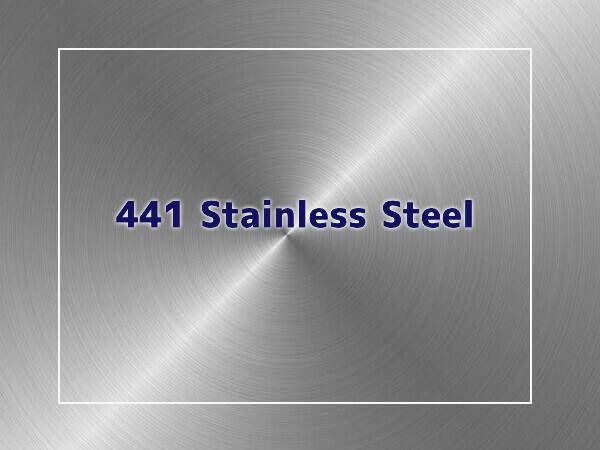
Stainless steel 441 is a ferritic stainless steel alloy with a higher chromium content than other ferritic steels. Its chemical composition consists of iron, chromium, titanium, niobium, manganese, silicon, carbon, phosphorus, sulfur and nitrogen. This unique combination of elements gives 441 stainless steel its desired properties. A key characteristic of 441 stainless steel is its excellent corrosion resistance. Due to its high chromium content, it forms a protective oxide layer on the surface when exposed to oxygen or moisture. This layer acts as a barrier against rust and other forms of corrosion. In addition to corrosion resistance, 441 stainless steel has good heat resistance and high-temperature strength. This stainless steel grade cannot be hardened by heat treatment. It can withstand high temperatures without losing structural integrity or experiencing significant deformation.
Another remarkable property of 441 stainless steel is its magnetic properties. Unlike austenitic stainless steels that are non-magnetic in the annealed state, 441 stainless steel retains its magnetism even after heat treatment. In addition, this grade of stainless steel has good formability and weldability. It can be easily formed into a variety of products through processes such as bending and welding without compromising its mechanical properties.
The composition and properties of stainless steel 441 make it ideal for automotive exhaust system applications, where thermal stability and corrosion resistance are key factors to consider. Its magnetic properties also make it suitable for certain electronic components that require magnetism while maintaining durability.
441 Stainless Steel Chemical Composition
| Grade | C | Si | Mn | P | S | Cr | Ni | Ti | Ti | Nb | Fe |
|---|---|---|---|---|---|---|---|---|---|---|---|
| 441 | 0.03 | 1.00 | 1.00 | 0.040 | 0.030 | 17.5 – 19.5 | 1.0 | 0.03 | 0.1–0.5 | [0.3 + (9× C)] min, 0.90 max | Bal |
441 Stainless Steel Mechanical Properties
| Grade | Tensile Strength MPa (Min) | Yield Strength 0.2% MPa(Min) | Elongation % | Hardness (Brinell) MAX | Hardness (Rockwell B) MAX |
|---|---|---|---|---|---|
| 441 | 414 | 241 | 20 | 190 | 90 |
The equivalent material to grade 441 stainless steel is 1.4509.
Physical Properties
| Property | 441 |
|---|---|
| Density, lb/in3 | 0.278 |
| Modulus of Elasticity, psi | 29.0 x 106 |
| Coefficient of Thermal Expansion, 68-212˚F, /˚F | 5.7 x 10-6 |
| Thermal Conductivity, Btu/ft hr ˚F | 12.1 |
| Specific Heat, Btu/lb ˚F | 0.11 |
| Electrical Resistivity, Microohm-in | 23.1 |
Applications
441 Stainless Steel is a versatile material that can be used in a variety of industries. Its unique properties make it suitable for a variety of uses, from automotive parts to kitchen utensils.
In the automotive industry, 441 stainless steel is commonly used in exhaust systems due to its excellent resistance to high temperatures and corrosive environments. It can withstand the harsh conditions of exhaust gases without losing structural integrity, making it a reliable choice for manufacturers.
Another important application for Stainless Steel 441 is in the construction industry. Its strength and durability make it ideal for building structures such as bridges, facades, and roofing systems. In addition, its resistance to oxidation ensures that these structures remain intact even in harsh weather conditions.
The food processing industry also benefits from using 441 stainless steel. Its corrosion resistance makes it ideal for manufacturing equipment such as food storage containers, countertops and sinks. This not only ensures compliance with hygiene standards but also guarantees longevity under demanding conditions.
In addition to these industries, stainless steel 441 grade is used in a variety of other applications, including furniture manufacturing, chemical processing plants and medical device production.
Overall, the versatility of 441 stainless steel allows it to be used in a wide range of industries where strength, corrosion resistance and durability are essential requirements.
Compared to Austenitic Stainless Steel
Stainless steel 441 has some distinct advantages over other types of stainless steel, such as 304 and 316. It has high corrosion resistance, making it ideal for use in environments where there is frequent exposure to moisture or chemicals. In addition, it has good heat resistance and can withstand high temperatures without losing its structural integrity.
Another major difference between stainless steel 441 and other types is its magnetic properties. While many grades of stainless steel are non-magnetic, 441 grade stainless steel exhibits a slight magnetic response due to its ferrite structure.
In terms of cost-effectiveness, 441 type stainless steel is typically less expensive than austenitic stainless steel such as 304 or 316. This makes it a popular choice for a variety of industrial and automotive applications where budgetary constraints may be an influencing factor.
However, one drawback to using stainless steel 441 is that under certain conditions, it may not provide the same level of corrosion resistance as some higher-grade alloys. Be sure to carefully consider the specific environment in which the material will be used before making a decision.
Standard Specifications
- ASTM A240/ASME SB240, Standard Specification for Chromium and Chromium-Nickel Stainless Steel Plate, Sheet, and Strip for Pressure Vessels and for General Applications
- ASTM A276, Standard Specification for Stainless Steel Bars and Shape
- ASTM A480, Standard Specification for General Requirements for Flat-Rolled Stainless and Heat-Resisting Steel Plate, Sheet, and Strip
- EN 10088-2: 2005 Stainless steels. Technical delivery conditions for sheet/plate and strip of corrosion resisting steels for general purposes
- EN 10088-3: 2005 Stainless steels. Technical delivery conditions for semi-finished products, bars, rods, wire, sections and bright products of corrosion resisting steels for general purposes
- EN 10028-7: 2007 Flat products made of steels for pressure purposes. Stainless steels
- EN 10296-2: 2005 Welded circular steel tubes for mechanical and general engineering purposes. Stainless steel. Technical delivery conditions
- EN 10088-1: 2005 Stainless steels. List of stainless steels
- EN 10088-4: 2009 Stainless steels. Technical delivery conditions for sheet/plate and strip of corrosion resisting steels for construction purposes
